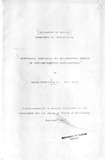| dc.contributor.author | Arimi, SM | |
| dc.date.accessioned | 2013-05-22T06:29:35Z | |
| dc.date.available | 2013-05-22T06:29:35Z | |
| dc.date.issued | 1987-09 | |
| dc.identifier.citation | Arimi, S.M(1987). Morphology, Haemolysis and Environmental sources of catalase-positive Campylobacters | en |
| dc.identifier.uri | http://erepository.uonbi.ac.ke:8080/xmlui/handle/123456789/24293 | |
| dc.description | PhD thesis | en |
| dc.description.abstract | Literature relating to the isolation, identification
and importance of catalase-positive campylobacters is reviewed
and the need for further work emphasized. Campylobacters
have been isolated directly, or after enrichment, from
faeces of diarrhoeic patients, from piglets and from sewage
and the efficiency of various procedures compared. Attempts
to devise a selective medium using dyes were unsuccessful.
Campylobacters occur commonly in Reading sewage, the sewage
treatment works removes 99.9%, but about 1010 campylobacters/
day are released into the nearby river from the
works. Biotyping and serotyping showed that the types in
sewage were similar to those isolated from human faeces ana
in beef, lamb and chicken meats on sale in Reading.
Differentiation betwn campylobacters was studied in
two regards. After developing a method involving treatment
with Mitomycin to facilitate production of long helical
organisms, measurements were made of wavelength and amplitude.
It was confirmed that, in general, the thermophilic
campylobacters have smaller wavelength and amplitude than
the C.fetus subspecies but there was an important exception
in that the long organisms of the type strain of f.laridis
(NCTC 11352) had wavelength indistinguishable from f.fetus.
Separation of the two subspecies of C.fetus could not be
achieved using this characteristic. Four strains
representing difrerent campylobactersall showed chdlldccl
handed helix when examined by scanning electron mocroscopy
Haemolysis hitherto generally regarded as not a property of
catalase-positive campylobacters, has been demonstrated by
most c.jejuni and a few c.coli strains when cultured on heart
infusion agar (Difco) at 42°C for 4 days. None of the
campylobacters gave a positive CAMP reaction with either
Staphylococcus aureus or Streptococcus agalactiae. | en |
| dc.language.iso | en | en |
| dc.subject | Morphology | en |
| dc.subject | Haemolysis | en |
| dc.subject | Environmental sources | en |
| dc.subject | Catalase-positive | en |
| dc.subject | Campylobacters | en |
| dc.title | Morphology, Haemolysis and Environmental sources of catalase-positive Campylobacters | en |
| dc.type | Thesis | en |
| local.publisher | Department of Public Health, pharmacology and Toxicology, University of Nairobi | en |

